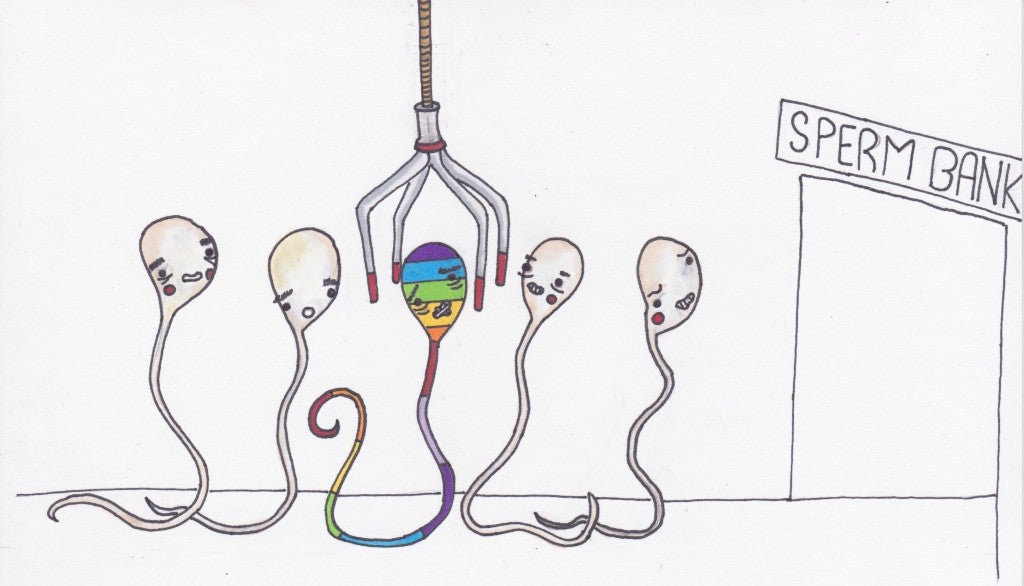While gay men can get married after last year’s historic Supreme Court ruling, the right to be paid to jerk off into a test tube so that a stranger might use that semen to get pregnant remains elusive. Like anti-sodomy laws, the FDA’s ban on gay sperm donors is rooted in homophobia, not science. But unlike anti-sodomy laws — which kept consensual anal sex a felony in every state before 1962, and were overturned by the Supreme Court in 2003 — the gay sperm ban is no legal vestige: It came into effect in 2005. At a moment when gay people enjoy unprecedented equality under the U.S. Constitution, it’s a quiet reminder of the stigma that’s still attached to gay bodies, one that still shapes medical policy and public opinion.
The sperm ban has its roots in the “gay blood ban” that started (more or less) when the first cases of AIDS were discovered among gay men in the early 1980s — as well as among those who had received recent blood transfusions. The FDA moved to exclude men who have sex with other men from the blood-donor pool for life. Most sperm banks applied this logic to reject gay donors as well.
But that ban was never officially on the books, since semen was never subject to the same rules as blood. Rather, the FDA decided to group semen together with other tissues such as “bones, veins, corneas [and] ligaments” when it issued new guidelines in 2005 for companies involved in tissue donation, which included a recommended ban on tissue from any man who had sex with another man in the past five years.
This might make sense when dealing with, say, a vein. Ruling out at-risk populations from the donor pool is logical when the tissue is harder to test for HIV. But sperm is frozen for six months before it’s donated so that labs can check for HIV multiple times in case it shows up months down the road. Not to mention that testing technology is more accurate than ever before, which is why scientists, activists and sperm industry officials have argued that we should just rely on labs — not population studies and risk factors — to determine, as opposed to assume, which samples have HIV.
“The part I find most offensive — and a little frightening — is that it isn’t based on good science,” Lambda Legal’s executive director said at the time. “There’s a steadily increasing trend of heterosexual transmission of HIV, and yet the FDA still has this notion that you protect people by putting gay men out of the pool.”

The FDA admitted as much at the time. One document plainly stated: “The FDA is very much aware that strict exclusion policies eliminate some safe donors,” i.e., gay men who practice safe sex. But it’s hard to view those policies as “strict” when the FDA gladly welcomes semen from straight men with risky sex lives: “[A] heterosexual man who had unprotected sex with HIV-positive prostitutes would be okay as a donor one year later, but a gay man in a monogamous, safe-sex relationship is not okay unless he’s been celibate for five years,” said Leland Traiman, who directed an Oakland clinic that kept serving gay donors in opposition to the ban (without, it should be noted, health issues or accidental transmissions of HIV).
A decade later, few people are talking about the ban, likely because it mostly affects gay men who’d want to donate sperm anonymously (which isn’t the lucrative experience it was once made out to be). Gay men who want to be sperm donors can give sperm to their friends; they just can’t donate it to strangers at a bank. And in the absence of public pressure, the FDA is unlikely to do much about it. Though it was hailed as progress in 2014 when the FDA moved to abandon the lifelong ban on blood from gay donors, the new rules are still as conservative as the ones for semen, with a required five-year abstinence period.
It seems to be a weird workaround toward discrimination. To critics, the FDA can say, “What blood or semen ban? We’re totally cool with the fluids of gay men!” Just so long as they stop doing the very activity which defines them as gay.

